Creating a solid foundation for your online business begins with a clear set of terms and conditions. But what exactly are they?
Terms and conditions are the rules, obligations, and responsibilities that outline the relationship between a business and its customers. These terms set the stage for smooth transactions, help prevent misunderstandings, and protect your business.
Whether you’re selling products, offering services, or running an online store, you need a terms and conditions document to establish and maintain a positive relationship with your customers.
In this guide, I’ll provide you with a free small business terms and conditions template, along with examples, that you can tailor to your specific needs.
- A comprehensive terms and conditions agreement protects your business and helps establish clear expectations with your customers.
- Be clear and concise when writing your T&Cs. Avoid legal jargon that may confuse your customers.
- Use clickwrap or browsewrap consent to ensure your customers agree to your terms and conditions. This will help you enforce your terms if necessary.
Table of Contents
PRO TIP: Take the hassle of writing your own terms and conditions away with our terms and conditions generator trusted by over 200,000 businesses. It’ll save you hours of work and possible costly legal mistakes.
Why Do You Need Terms and Conditions for Your Small Business?
You need terms and conditions for your small business to protect your interests and set clear expectations with your customers. Terms and conditions are part of what keeps your business secure. Basically, they help:
- Safeguard your business from potential lawsuits
- Clarify customer obligations by outlining what they can and cannot do
- Set payment terms, including payment methods, deadlines, and consequences for non-payment
- Limit your liability in case of disputes and dissatisfaction
- Protect your intellectual property
Beyond the basics, you also have to recognize that this agreement, also known as terms of use or terms of service, isn’t just about the legalities. It’s also about building trust with your customers.
For me, I choose to look at it as a way to promote transparency, which then leads to stronger customer relationships. When you don’t ignore the importance of terms and conditions for your site, your business will become more resilient and reliable in the long run.
Small business terms and conditions agreements aren’t just legal jargon. They help ensure the smooth operation of your business.
14 Key Components of Small Business Terms and Conditions
Effective terms and conditions for small businesses should include certain foundational elements. This way, all parties involved know their obligations and rights. Here are key components to add:

1. Introduction
This opening paragraph serves as a brief overview of the document’s purpose and scope. Here’s a good example of a T&C introduction from Kitty Meow Boutique:

It’s a good example of an introduction because it:
- Identifies the parties involved by stating who the agreement is between
- Explains what the terms and conditions cover, such as the use of the website, products, or services
- Indicates that by using the website or services, the user agrees to be bound by these terms and conditions
PRO TIP: Start your terms with clarity and purpose. It’s your chance to make a good first impression that aligns with the rest of the document’s content.
2. Definitions
This section acts as a mini-glossary where you clarify industry-specific jargon that appears throughout the document. This way, anyone reading it understands exactly what you mean by certain phrases or words.
For example, if you’re an online clothing store, you might define terms like “size chart,” “exchange policy,” “backorder,” and other technical terms relevant to your business. A software company might need to define terms like “license,” “update,” and “support.”
Ultimately, the goal is to prevent confusion and make your terms easier to understand so that your customers have a smooth experience.
3. User Responsibilities
This section is an important part of these terms and conditions because it spells out what users are expected to do and what they should steer clear of while interacting with your services or products.
Sharay’s Ghana Style Brittle’s T&C is a good example of this:
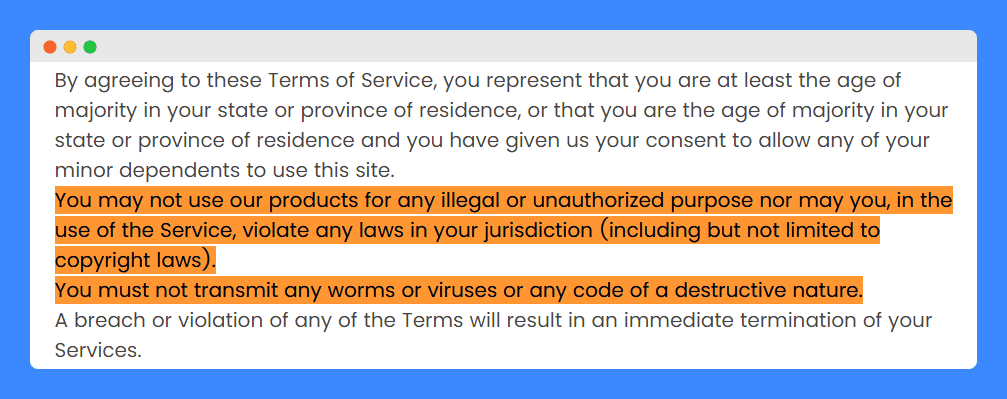
You can also include requirements for account security, like keeping passwords confidential, or rules around acceptable behavior on a community forum to prevent abuse or harassment.
4. Payment Terms
This is where you outline the payment policies for your products or services. You can include accepted payment methods (credit cards, PayPal, bank transfer) and payment deadlines.
As a business owner myself, I also make sure to include details like whether taxes are included in the prices if there are any additional charges that customers should be aware of, and the consequences of missed payments.
5. Refund and Cancellation Policy
In this section, you detail the process for customers to follow if they want to return a product or cancel a service, as well as under what conditions they can expect a refund.
Incorporating a clear refund and cancellation policy within your terms and conditions helps you set expectations right from the start. Customers appreciate transparency, and knowing these things upfront can make them feel more confident and secure in their purchases.
Moreover, a 2021/2022 global survey revealed that 49% of online buyers in the US returned a product in the last 12 months.

Given this high rate of returns, it has become even more crucial for businesses to provide their customers with a clear path for resolving issues with their purchases. A clear refund and cancellation policy can help with that.
PRO TIP: You can use a free refund policy generator as a starting point. However, make sure you tailor it to your specific needs and align it with your overall T&C.
6. Intellectual Property Rights
Another important component to include in your terms and conditions document is an intellectual property notice. Basically, this section outlines your ownership of your intellectual property and the restrictions on how customers can use it.
For instance, here’s how Begonia & Bench protects its intellectual property through its T&C:
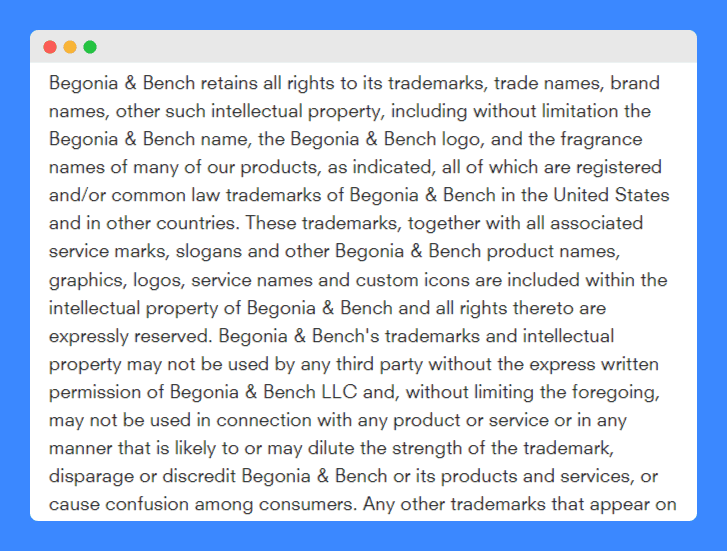
Using simple and straightforward language, it was able to:
- Clearly state that they own all intellectual property related to their website, products, or services; and
- Specify how customers can use their intellectual property, including prohibiting them from copying, modifying, or distributing your content without their permission.
7. Privacy Policy Reference
This clause in your terms and conditions links to or summarizes your privacy policy. Doing so makes it clear to your customers that their personal information is treated with care and respect.
In my case, I use this section to reassure my site visitors that their data, such as names, addresses, and payment details, are handled securely and in compliance with relevant privacy laws.
By detailing how my website collects, uses, stores, and protects customer data, I am able to make them feel informed and secure when engaging with my business.
8. Limitation of Liability
Your website terms and conditions must include the extent to which your business can be held accountable for any issues that arise from the use of your services or products.
For instance, if you sell products online, this clause would clarify that while you ensure product quality, you cannot be held liable for unforeseen damages or issues that occur once the product is used beyond your control. You could say,
“[Your Business Name] is not liable for any indirect, incidental, or consequential damages, including but not limited to, lost profits, lost data, or emotional distress, arising out of or in connection with your use of our website or services.”
That said, it’s also important to note that including this clause does not shield you from all liabilities. Depending on local laws and the nature of your business, there may still be scenarios where liability cannot be fully excluded.
9. Dispute Resolution
This part of a T&C serves to prevent disputes from escalating into more severe legal challenges. For example, you can say that any disagreements arising from or related to the use of your services must first go through an informal negotiation period before any formal proceedings can begin.
The methods outlined in your terms and your exclusive remedy for resolving disputes can potentially save both parties time and money compared to court proceedings.
PRO TIP: Consider incorporating a neutral third-party mediator in your dispute resolution process. This approach can often lead to fairer, more balanced outcomes.
10. Termination of Service
Here’s another critical provision of these terms and conditions. It details how and under what circumstances either you or your customers can end the relationship.
For example, here is how Blondie Apparel worded its termination policy in its Terms of Service:
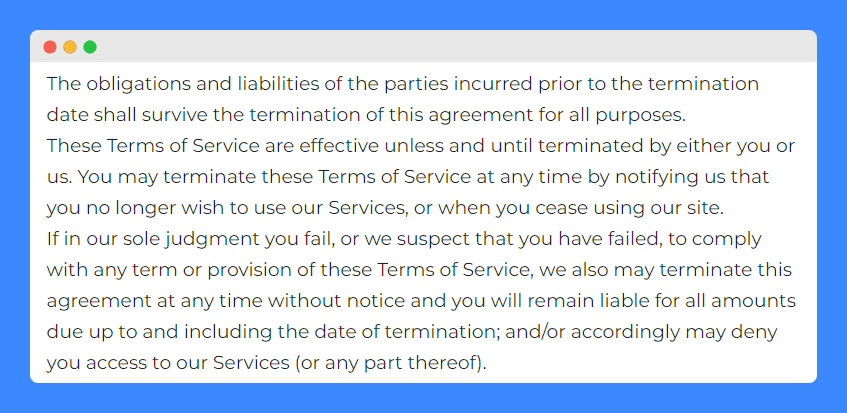
Basically, you’ll want to outline how customers can terminate their accounts, such as by contacting customer service or closing their accounts through your website.
Just like Blondie Apparel did, you should also outline the conditions under which you might terminate a customer’s access to your services, typically due to non-compliance with your terms.
11. Changes to Terms
As a business owner, you want to be able to adapt to new laws, business needs, or market conditions. This is where this section of your T&C comes in.
Here, you would typically state that you reserve the right to modify the terms at any time. It’s also where you detail how you will notify users of these changes. Lastly, encourage them to review the T&C periodically to stay informed about any updates.
PRO TIP: Make it clear that the revised terms become effective after a certain notification period. This ensures users are aware of the current rules and policies governing your service.
12. Governing Law
This section specifies which jurisdiction’s laws will be used to interpret and enforce the terms of the agreement. For instance, you could mention:
- Consumer protection laws, which vary by state and country but generally protect the rights of consumers against unfair practices.
- E-commerce regulations, which cover the sale of goods and services online and include rules on online transactions, consumer rights, and digital contracts.
- Privacy laws, such as the General Data Protection Regulation (GDPR) in Europe or the California Consumer Privacy Act (CCPA), which dictate how businesses must handle personal information.
- Advertising laws, which ensure that advertising is fair, truthful, and non-deceptive, and complies with specific standards and practices.
More than anything, adding this clause helps clarify legal uncertainties that could arise due to the global nature of the internet.
13. Contact Information
This part of the document should include relevant contact details such as your business’s email address, phone number, and possibly a physical or mailing address.
When customers know they can easily get in touch with you, it reassures them that they’re dealing with a transparent and accessible business.
It’s also practical. I learned from experience that providing this information upfront can help prevent misunderstandings and solve issues more quickly.
You can maintain a positive relationship with your customers by showing them you’re open to communication. You can then improve your services based on their feedback.
14. Acknowledgment and Acceptance of Terms
Often located at the end of your terms and conditions agreement, this crucial part serves as the user’s official nod of approval. You can say,
“By using our website or services, you acknowledge that you have read the terms and conditions and agree to be bound by them.”
This clause implies agreement to your terms. It’s a formal acknowledgment that they are aware of the expectations and legal stipulations laid out in the document, which can help protect your business in disputes or legal challenges.
How To Write Terms and Conditions for Small Business
If you are a small business owner looking to draft terms and conditions, here’s a rundown of your options, tailored to fit different needs and budgets:
1. Hire a Lawyer
Hiring a lawyer to write terms and conditions for your business is a common first thought. However, it is often a costly and time-consuming option that may not be feasible for most small businesses.
2. Use a Generator
A terms and conditions generator, like the one we offer, is a more accessible and cost-effective solution. It asks a series of questions about your business and whips up a document tailored to your needs, just like a lawyer would but without the hefty fees.
3. Use a Template
Another accessible option is to use a free terms and conditions template. Templates provide a basic framework you can personalize, allowing you to create a more customized terms and conditions agreement without starting from scratch. Of course, it takes a lot more work as you have to figure out laws and regulations to ensure proper fit.
4. Write It Yourself (Not Recommended)
Unless you have a strong legal background, you might be putting your business at risk if you write your own terms and conditions document. In my opinion, using a generator or template is still the best way to draft a good terms and conditions agreement for any small business.
Small Business Terms and Conditions Template
To get you started on the right track, here’s a sample small business terms and conditions template you can start with. Whether you’re launching a new online shop, offering services, or scaling your existing business, you can use this template for your specific needs.
Note though that while it outlines the essential points, it’s important to personalize and modify the content to suit your specific business needs and ensure that any relevant legal considerations are properly addressed.
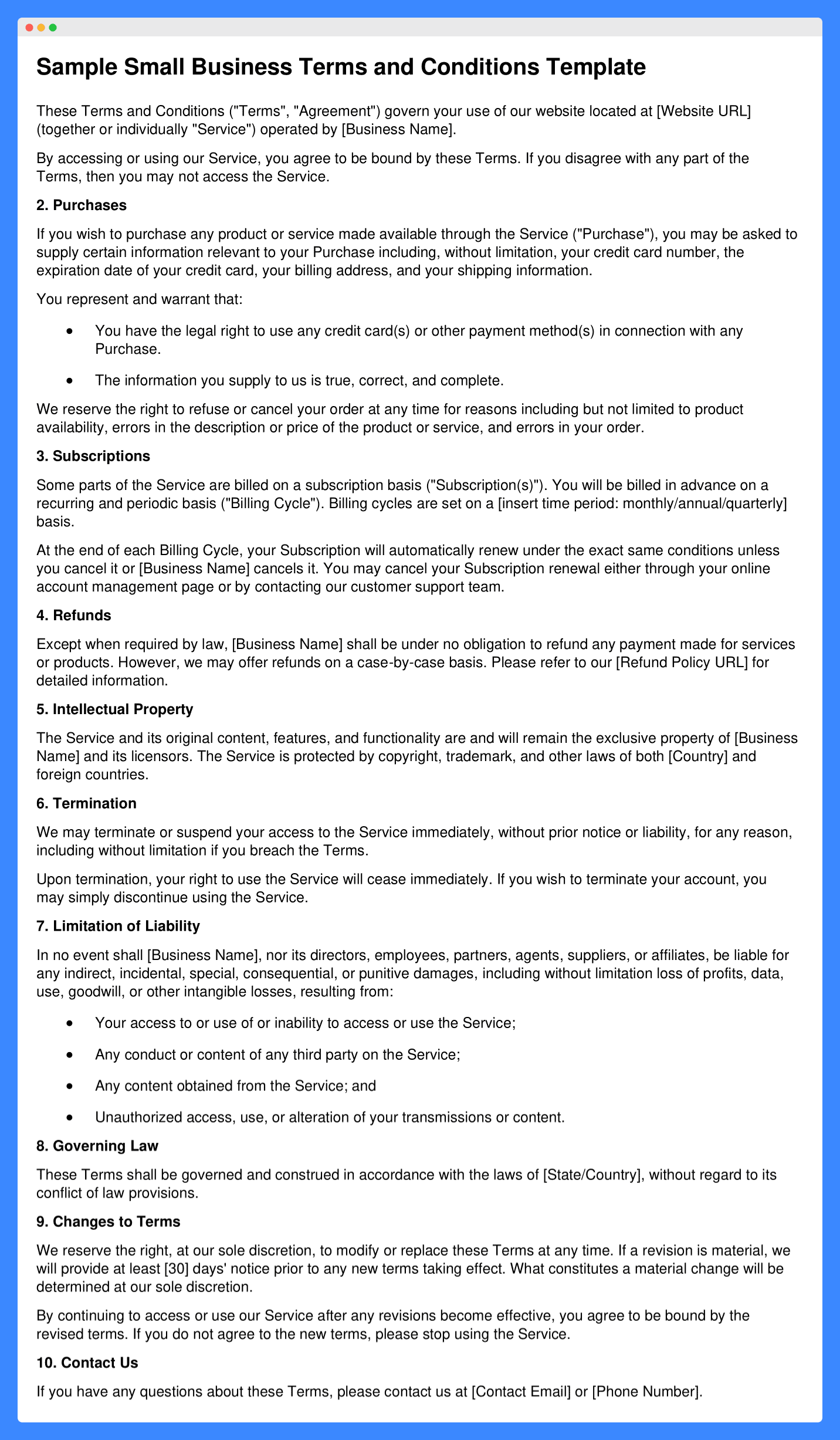
Small Business Terms and Conditions Examples You Can Learn From
Want to see how other small businesses have crafted their terms and conditions? Take a look at these real-world examples to get inspired and learn best practices:
1. Moontime Tea
If you’re looking for a stellar example of terms and conditions for small businesses, check out Moontime Tea’s below. The use of simple language makes it easily understandable for customers.
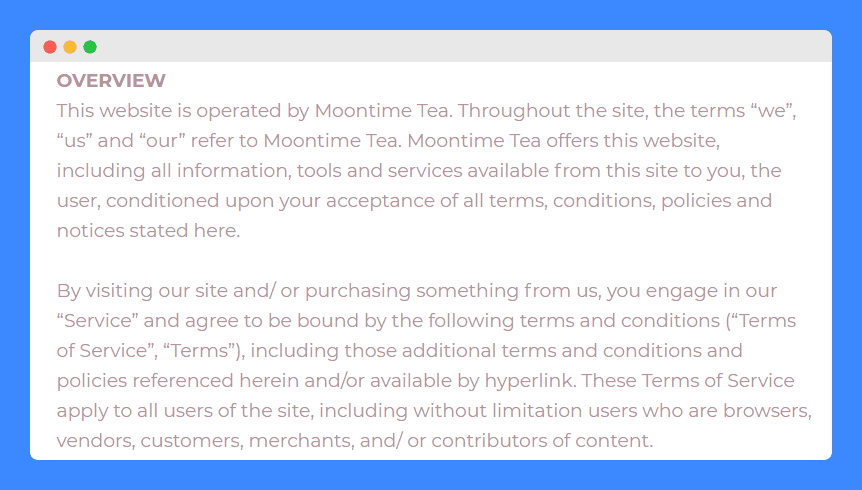
What’s more, Moontime Tea uses subheaders to break up the text into smaller, more digestible sections, making it easier for customers to find the information they need.
2. Pregnant and Hungry
Pregnant and Hungry has a robust terms and conditions policy that effectively outlines its business practices. The clear organization of the document makes it easy for customers to navigate and read.

Another standout feature is the complete contact information for their copyright agent within their terms and conditions document. This makes it easy for customers to report any copyright infringement issues.
3. Clip Different
Through its T&C, Clip Different effectively distances itself from potential liabilities associated with third-party sites.
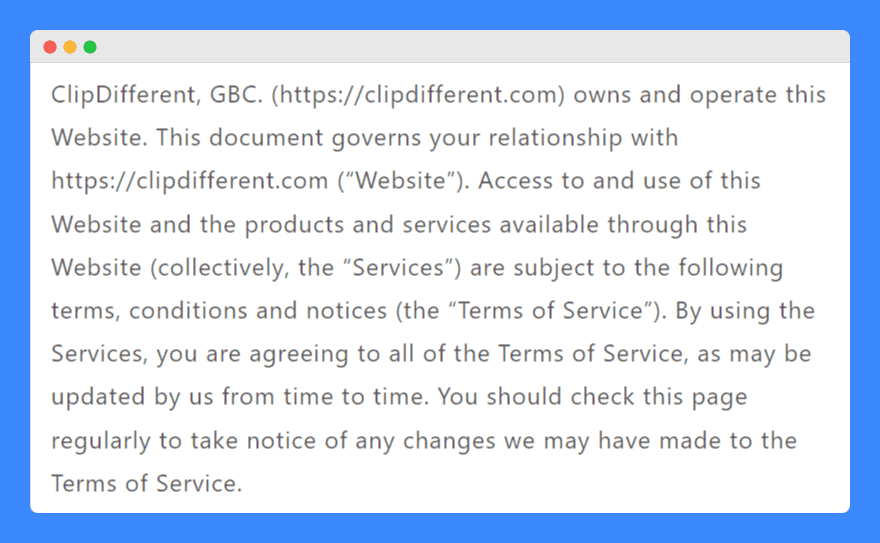
It says that, while the website may contain links to other websites, it doesn’t mean that they operate these sites. As such, they shouldn’t be held responsible for issues that may arise from their use.
This clause in their terms and conditions agreements benefits the company by setting clear expectations about the nature of linked content.
4. Crystalyn Aucoin Jewelry
Crystalyn Aucoin Jewelry’s T&C explicitly outlines user responsibilities and the consequences of breaching these terms. This helps users understand their obligations when engaging with the website and purchasing products.

By specifying the actions considered as a breach of these terms, such as unauthorized use of content or fraudulent activity, and detailing the potential consequences, including account suspension or legal action, the company effectively maintains a secure and respectful environment.
5. The Gray Muse
This sample terms and conditions for small business from The Gray Muse offers a comprehensive and well-structured agreement that covers all the essential elements.

They clearly outline their payment terms, refund policy, intellectual property rights, and user responsibilities.
The detailed explanations provided in these terms set a clear framework for both legal protection and customer interaction. In turn, this helps THe Gray Muse maintain a good relationship with its customers.
Where To Display Terms and Conditions on Your Small Business Website
Display your terms and conditions where they are easily accessible. This way, your customers are aware of the rules and expectations governing their use of your website and services.
Here are prime spots where you can post your terms and conditions:
- Website footer: This is a common location for posting a terms and conditions link.
- Checkout page: Link your terms and conditions during checkout so customers can read them before completing their purchase.
- Sign-up page: If you require users to create an account, include links to your terms and conditions and privacy policies here.
- Privacy Policy page: Your privacy policy can also link to your terms and conditions, and vice versa since they are closely related.
How To Ensure Your Customers Agree to Your Small Business Terms and Conditions
To ensure that your customers agree to your terms and effectively enforce your terms and conditions, it’s crucial to use clear methods of consent. Two common approaches are clickwrap and browsewrap consent.
Clickwrap Consent
Clickwrap consent requires users to take explicit action to agree to your terms, typically by clicking a checkbox or a button during the signup, purchase, or registration processes.
This method ensures express consent to your terms and conditions rather than implied consent, making it more legally robust. The explicit nature of this action helps enforce your terms and conditions because it demonstrates clear agreement from the user.
Browsewrap Consent
Browsewrap consent involves posting your terms and conditions on your website, usually with a link in the footer, and assuming that by continuing to use the site, users agree to your terms.
This method relies more on implied consent, which can be less enforceable because the user does not take any active steps to acknowledge agreement.
To strengthen this approach and lean towards express consent, it’s advisable to clearly inform users that their continued use of the site constitutes agreement to the terms linked on the page.
Frequently Asked Questions
Are terms and conditions legally binding for small businesses?
Yes, terms and conditions are legally binding for small businesses if properly drafted and agreed upon. They set enforceable rules and expectations for both parties.
How often should I update my small business terms and conditions?
Update your terms and conditions annually or whenever significant business changes occur. Regular updates ensure they remain relevant and enforceable.
Do terms and conditions protect my small business from legal risks?
Yes, well-drafted terms and conditions can protect your business by clarifying rights and responsibilities. They mitigate legal risks by setting clear expectations.
How do I ensure my small business terms and conditions comply with the law?
Consult with a legal expert to ensure your terms comply with applicable laws. Regularly review and update them to reflect legal changes.
Can I modify my terms and conditions after a customer has already agreed to them?
Yes, you can modify terms, but customers must be notified and agree to the changes. Include a clause on how updates are handled in your original terms.



